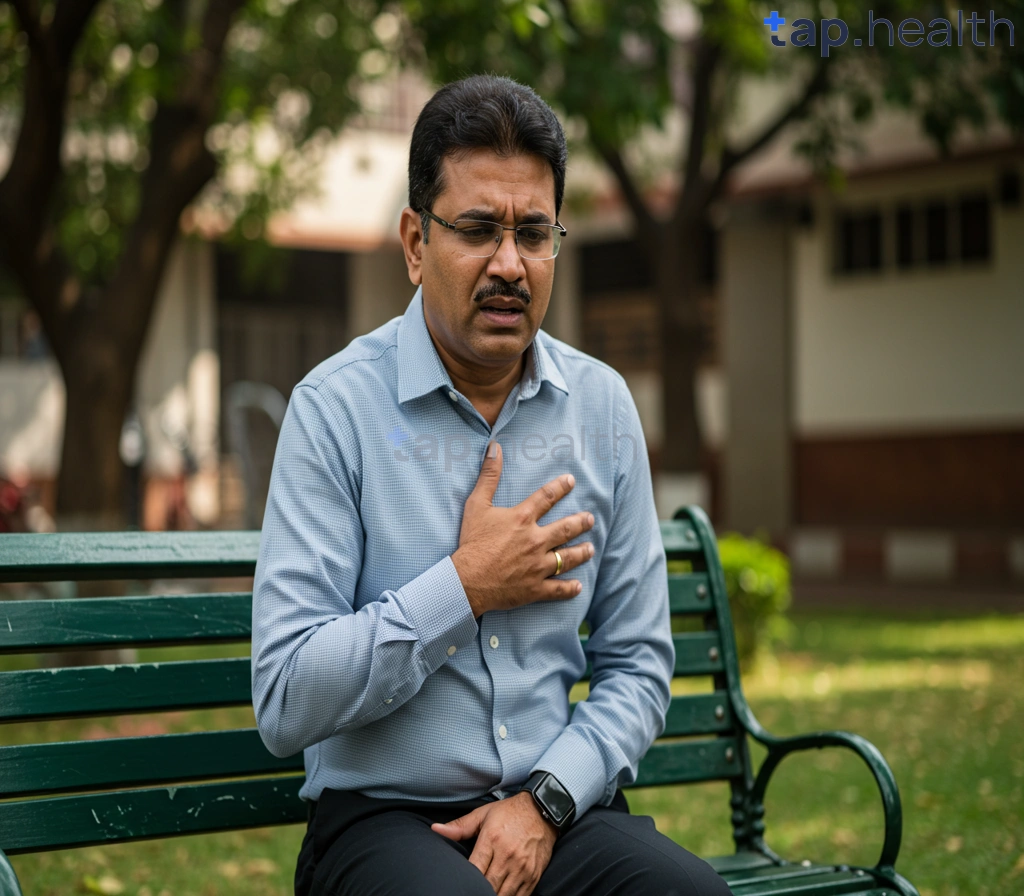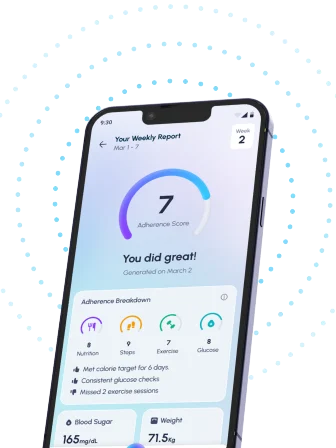Table of Contents
- Spotting Diabetic Heart Attack Symptoms: A Critical Guide
- Silent Heart Attacks in Diabetics: Recognizing the Warning Signs
- Is It a Heart Attack? Understanding Diabetic Symptoms
- When to Call Emergency Services for Diabetic Heart Issues
- Diabetic Heart Attack vs. Other Chest Pains: Key Differences
- Frequently Asked Questions
- References
Heart attacks are serious, and for people with diabetes, recognizing the symptoms can be even more critical. Recognizing diabetic heart attack symptoms often presents unique challenges, as they can be less noticeable or manifest differently than in individuals without diabetes. This can lead to delayed treatment, increasing the risk of complications. This blog post will help you understand these subtle signs, empowering you to seek immediate help when you or a loved one needs it most. Let’s explore the key differences and learn how to act quickly to save a life.
Spotting Diabetic Heart Attack Symptoms: A Critical Guide
Heart attacks in individuals with diabetes can present differently than in those without the condition, making early recognition crucial. The alarming statistic that 50% of diabetes cases worldwide are undiagnosed, as highlighted by the International Diabetes Federation, underscores the importance of understanding these variations. Many individuals in India and tropical countries may not be aware of these subtle differences.
Silent Heart Attacks and Atypical Symptoms
Diabetic patients sometimes experience “silent” heart attacks, meaning they have minimal or no chest pain. Instead, they might experience unusual symptoms like intense fatigue, shortness of breath, nausea, or unusual sweating. These symptoms can easily be dismissed, particularly in hot and humid climates common to many tropical regions, where fatigue is often attributed to the weather. It’s critical to be vigilant about any unusual discomfort or change in your health. Early detection is key, and understanding the 10 Early Signs and Symptoms of Diabetes? can be helpful in preventing complications.
Recognizing the Warning Signs
In addition to atypical symptoms, traditional heart attack symptoms like chest pain or pressure, radiating to the jaw, arm, or back, can still occur in individuals with diabetes, but may be less intense or easily overlooked. Prompt action is vital. If you experience any of these symptoms, even if mild, seek immediate medical attention. Delaying treatment can significantly increase the risk of complications and mortality. Taking proactive steps to Protect Your Heart from Diabetes is crucial.
Seeking Immediate Help in India and Tropical Countries
In India and many tropical countries, access to healthcare can vary. Understanding the specific warning signs of a heart attack in the context of diabetes is even more crucial. Don’t hesitate to contact emergency services or visit the nearest hospital immediately if you suspect a heart attack. Early diagnosis and treatment significantly improve outcomes. Knowing your risk factors and being proactive about your health is essential for preventing heart attacks and other diabetic complications.
Silent Heart Attacks in Diabetics: Recognizing the Warning Signs
The Silent Threat
Diabetes significantly increases the risk of heart attack, often presenting atypically. Many individuals with diabetes experience what are known as “silent” heart attacks, meaning they lack the classic chest pain symptoms. This is particularly dangerous, as delayed treatment can lead to severe complications. The lack of typical symptoms makes early detection crucial, especially in high-risk groups like smokers. In fact, research shows that smokers with diabetes face double the mortality rate from cardiovascular issues. This underscores the urgent need for heightened awareness and prompt medical attention. Increased heart rate, a symptom sometimes associated with silent heart attacks, can be further complicated by diabetes. For more information on the connection between diabetes and heart rate, you may find our article on Does Diabetes Cause Tachycardia? helpful.
Recognizing the Subtle Signs
Instead of crushing chest pain, diabetics might experience less obvious symptoms like unusual fatigue, shortness of breath, or discomfort in the jaw, back, or neck. These subtle symptoms may be easily dismissed or attributed to other conditions, delaying vital treatment. In hot and humid climates prevalent across many Indian and tropical countries, these symptoms can be easily confused with heat exhaustion. Therefore, it is especially important to be vigilant and seek medical attention if you experience any unusual symptoms, even if they seem mild. As we age, managing diabetes becomes even more crucial, and recognizing the changes in symptoms becomes increasingly important. Learn more about Managing Diabetes as You Age: Challenges and Solutions.
Taking Action
Given the heightened risk and atypical presentation of heart attacks in diabetics, particularly in regions with warm climates, prompt medical attention is paramount. Don’t hesitate to contact emergency services or your doctor if you experience any concerning symptoms. Early diagnosis and treatment are vital in improving outcomes and reducing the devastating consequences of a silent heart attack. Your life might depend on it.
Is It a Heart Attack? Understanding Diabetic Symptoms
Silent Heart Attacks and the Diabetic Population
Diabetes significantly increases the risk of heart attack, often presenting with atypical symptoms or even silently. This means many individuals with diabetes may not experience the classic chest pain associated with a heart attack. Over 30% of diabetes patients have HbA1c levels above 9%, indicating poor blood sugar control and a heightened risk of cardiovascular complications, including silent myocardial infarctions. Recognizing the subtle signs is crucial for timely intervention and improved outcomes.
Atypical Symptoms in Tropical Climates
In Indian and tropical countries, certain factors can further complicate the recognition of diabetic heart attack symptoms. High humidity and temperature can sometimes mask or mimic other conditions, making diagnosis more challenging. Individuals might experience unusual fatigue, shortness of breath, or nausea, rather than the typical crushing chest pain. These symptoms are often dismissed, delaying crucial medical attention. The impact of heat on diabetic individuals is significant; for more information, you can read our blog on How Does Heat Affect Diabetics?.
Recognizing the Warning Signs
Pay close attention to any unusual discomfort in your chest, jaw, neck, back, or arm – even if it’s mild or different from what you’d expect. Other symptoms include sweating, dizziness, sudden weakness, or unexplained anxiety. If you experience any of these symptoms, especially if you have diabetes, seek immediate medical help. Don’t hesitate to contact emergency services or visit the nearest hospital. Early diagnosis and treatment are vital for minimizing damage and improving survival rates. Experiencing unusual fatigue, like feeling sleepy after eating, can also be a warning sign. Learn more about this potential symptom in our blog post: Is feeling sleepy after eating a sign of diabetes?
Seeking Immediate Medical Attention
In Indian and tropical countries, access to healthcare can vary significantly. Locate the nearest emergency medical facility and familiarize yourself with the local emergency contact numbers. Don’t delay seeking help; prompt action can make a life-or-death difference. Remember, early intervention significantly increases the chances of a positive outcome.
When to Call Emergency Services for Diabetic Heart Issues
Recognizing the signs of a heart attack in individuals with diabetes is crucial, especially considering that women with diabetes face a 40% higher risk of heart disease than men with diabetes. Early intervention is key to improving outcomes, and knowing when to seek immediate medical attention can be life-saving. In many Indian and tropical countries, access to rapid emergency medical services can vary, highlighting the importance of recognizing symptoms quickly.
Recognizing the Symptoms
Diabetic heart attacks may present differently than those in non-diabetics. Classic chest pain might be less pronounced or even absent. Instead, look for symptoms like intense fatigue, unexplained shortness of breath, nausea or vomiting, upper back or jaw pain, and dizziness or lightheadedness. These symptoms, especially when combined, should trigger immediate action. Don’t dismiss them as simple indigestion or stress; in individuals with diabetes, these could indicate a serious cardiac event. Remember, time is critical. Managing blood sugar levels is also crucial; for instance, understanding when Is Blood Sugar Over 400 an Emergency? can help prevent serious complications.
When to Call for Help
If you experience any of the above symptoms, especially if they’re sudden or unusually severe, call emergency services immediately. Don’t hesitate; even if you’re unsure, it’s always better to err on the side of caution. In many parts of India and tropical regions, access to advanced cardiac care might involve navigating specific hospital networks or ambulance services. Familiarize yourself with your local emergency contact numbers and nearest cardiac care facilities beforehand. Having a plan in place can significantly reduce the time it takes to get the necessary help.
Taking Proactive Steps
Regular check-ups with your doctor, including monitoring blood glucose levels and blood pressure, are vital for managing diabetes and reducing the risk of heart disease. Discuss any concerns about heart health with your physician, and don’t hesitate to seek immediate medical attention if you suspect a heart attack. Your life depends on it. Remember that even seemingly small health decisions can have an impact. For example, learning more about Can a Diabetic Person Donate Blood? can highlight the importance of proactive health management.
Diabetic Heart Attack vs. Other Chest Pains: Key Differences
Differentiating a diabetic heart attack from other chest pains can be challenging, especially in regions like India and other tropical countries where access to immediate healthcare might be limited. The symptoms can be atypical or even absent in some cases, making early detection crucial. This is partly due to the prevalence of diabetic neuropathy, affecting 30-50% of patients. Diabetic neuropathy can significantly alter pain perception, meaning chest pain might be less intense or even completely absent, leading to delayed diagnosis and treatment.
Silent Heart Attacks
One key difference is the possibility of a “silent” heart attack. Individuals with diabetes may experience a heart attack with minimal or no chest pain. Instead, they might notice shortness of breath, unusual fatigue, nausea, or discomfort in the jaw, neck, or back. These atypical symptoms are more common in diabetics and can easily be mistaken for other ailments. The absence of typical chest pain makes prompt medical attention even more critical.
Chest Pain in Other Conditions
Other conditions prevalent in tropical climates, such as indigestion, acid reflux, and muscle strains, can mimic the symptoms of a heart attack. However, the intensity, duration, and associated symptoms help differentiate them. Indigestion usually involves a burning sensation in the upper abdomen, while muscle strains cause localized pain that worsens with movement. A heart attack usually involves a crushing or squeezing sensation in the chest that radiates to other areas and doesn’t improve with rest or medication. Understanding the different types of diabetes can also be helpful in understanding the risk factors for heart attack. For example, learning more about the differences between Which Diabetes Is Worse: Type 1 or Type 2? Key Comparisons can provide insights into potential complications. Furthermore, conditions like diabetic neuropathy, as discussed earlier, can manifest in various ways, including Can Diabetes Cause Heel Pain?.
Seeking Immediate Help
If you experience any chest discomfort, shortness of breath, or unusual fatigue, especially if you have diabetes, seek immediate medical attention. Don’t delay treatment, even if the symptoms seem mild. In India and other tropical countries with varying access to healthcare, early identification and swift response to potential heart attack symptoms significantly improve the chances of successful treatment and better outcomes. Remember, timely intervention is paramount.
Frequently Asked Questions
Q1. What are the common symptoms of a heart attack in people with diabetes?
Diabetic heart attacks can present differently than in people without diabetes. While chest pain is a classic symptom, it may be less intense or absent. Instead, look for intense fatigue, shortness of breath, nausea, or unusual sweating. These can easily be mistaken for other conditions.
Q2. How are diabetic heart attacks different from typical heart attacks?
Diabetic heart attacks often have atypical symptoms, sometimes occurring silently without the usual chest pain or pressure radiating to the jaw or arm. Individuals with diabetes may experience symptoms like extreme fatigue, nausea, or unusual sweating.
Q3. Why is it crucial to seek immediate medical help if I experience unusual symptoms?
Delaying treatment for a heart attack significantly increases the risk of complications and mortality. Prompt medical attention is critical to improve treatment outcomes and reduce the risk of severe consequences, especially in cases of diabetic heart attacks which may be harder to diagnose.
Q4. I live in a hot climate. How can I tell the difference between heat-related symptoms and a heart attack?
Symptoms of a diabetic heart attack, such as fatigue, shortness of breath, nausea, or unusual sweating, can mimic heat-related symptoms. If you experience any unusual symptoms, even mild ones, seek immediate medical help to rule out a heart attack.
Q5. Why is the global prevalence of undiagnosed diabetes relevant to recognizing a diabetic heart attack?
The high percentage of undiagnosed diabetes worldwide highlights the importance of recognizing the atypical symptoms of diabetic heart attacks. Many people may not realize they have diabetes, making early diagnosis and treatment even more challenging.
References
- A Practical Guide to Integrated Type 2 Diabetes Care: https://www.hse.ie/eng/services/list/2/primarycare/east-coast-diabetes-service/management-of-type-2-diabetes/diabetes-and-pregnancy/icgp-guide-to-integrated-type-2.pdf
- Diagnosis and Management of Type 2 Diabetes: https://apps.who.int/iris/rest/bitstreams/1274478/retrieve




